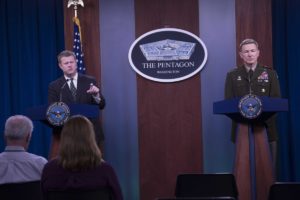Army senior leadership on Thursday detailed the latest on its ongoing response to the coronavirus outbreak, including recruiting retired medics to volunteer for assistance efforts and working with individual states to ensure contractors have capabilities to keep production lines open.
The latest update arrives as the service has seen a jump in confirmed COVID-19 cases from 45 this past Friday to 288 as of this morning, covering 100 soldiers, 64 civilians, 65 family members, 9 cadets and 50 contractors.

Gen. James McConville, the Army chief of staff, told reporters the service has reached out to retired officers and non-commissioned officers with relevant medical skills to join the response effort, as the service readies to deploy field hospital capabilities to the hardest hit cities.
“This is a voluntary opportunity for our medical soldiers for life to return to the fight, if they so choose, especially if they are not currently assisting their local communities. So far the initial responses have been very, very positive,” McConville said.
McConville confirmed two Army field hospital centers will arrive in New York City on Monday with capacity to provide 284 beds and an additional field hospital will deploy to Seattle on Monday with 248 beds.
“What you’re going to see is a good whole-of-government effort where the state is contributing, FEMA is contributing a lot of the equipment and structure inside the [temporary hospital site] and then we will be providing personnel to staff that hospital and do non-COVID-19 care,” McConville said. “It’s about speed. We got an order on Tuesday. They were on the road Wednesday. They’re doing the coordination and this weekend we’re putting people in there and on Monday we expect to be taking care of patients.”
Lt. Gen. Charles Flynn, deputy chief of staff for operations, plans and training, added the deployed medical personnel will focus on providing beds for non-COVID-19 patients to ensure local hospitals have the capacity to treat those with the virus.
“What they’re really doing is they’re taking pressure off the local and state health care system and moving patients into that [temporary hospital] facility so that we can help those patients, because there are still going to be people with broken legs and car accidents that will need care,” Flynn said.
McConville also noted the Army Corps of Engineers is now in contact with all 50 states to conduct site assessments for additional care facilities, while continuing work in New York to set up temporary ICU-like spaces.
Army Secretary Ryan McCarthy acknowledged challenges with keeping production lines for current contracts running while states finalize their individual restrictions on work environments during the pandemic.
“We have many contractors that are still reporting to work, and they’re bending metal and continuing to progress. What we’re doing is working with the states, because it really is a state-by-state-related issue. If there’s a manufacturer in Florida that has parts of their manufacturing division in New York or Connecticut, you have to work through some of these issues about their employees traveling from state to state,” McCarthy said.
McCarthy told reporters the service’s top acquisition official and head of the modernization-focused Futures Command have conducted an assessment of the industrial base to identify current gaps that need to be addressed.
“It’s a very complex issue but we’ve been pretty blessed with how these manufacturers are stepping up and continuing to put the measures in place so their employees can continue to work and head down that modernization path,” McCarthy said.